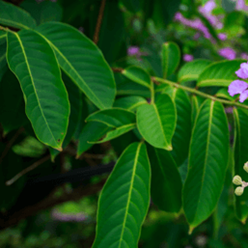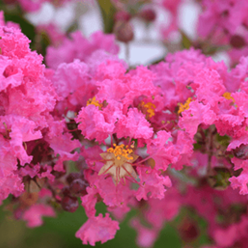Isn’t it so rewarding to be able to confidently identify the trees in your yard? If you’re looking to boost your tree expertise, you’re in the right place! Here’s where you’ll learn all the ins and outs of crepe myrtle trees.
First up, what does crepe myrtle look like? These trees can be multi-stemmed or have single trunks that burst into a beautiful display of white, pink, purple or red flowers.

Use the handy guide below to figure out if you’re the lucky owner of a crepe myrtle tree.
Crepe myrtle tree identification by leaf
Crepe myrtle tree leaves are dark green with an oval shape. During the fall season, the leaves switch to rich shades of red, orange or yellow.

Crepe myrtle tree identification by flower
Crepe myrtle colors range from pink to deep red, to white or light purple. The flowers have a dainty feel with each petal looking ruffled (hence the name).
Crepe myrtle tree identification by bark

For much of the year, crepemyrtle tree bark is smooth to the touch and dusty gray or light brown colored. In winter, the top layer of bark peels away, exposing cream or pinkish-orange wood underneath.
How to care for crepe myrtle
Convinced you have a crepe myrtle, or looking to add one to your yard? Read these essentials crepe myrtle care tips.
- Grow zones: Crepe myrtle grows best in hardiness zones 7-10. In these areas, the temperature stays mild with not much risk for harshly cold days. Plus, crepe myrtles are very drought tolerant, ready to take on the heat these hardiness zones are known for.
- Where to plant: Nearly all soil types are a good option for your crepe myrtle tree. Just make sure the soil is well-draining.
- Height and spread: Crepe myrtle trees come in several sizes, from tiny dwarf trees grown as shrubs to taller and wider mid-size trees. Depending on what type you get, you can expect your tree to grow anywhere from 5-25 feet tall and about 5-15 feet wide.
- Sunlight: Crepe myrtle trees thrive in full sun—meaning at least 6 hours of uninterrupted sunlight every day.
- When do crepe myrtles bloom?: Vibrant crepe myrtle flowers appear sometime between late spring and early summer. June is typically their peak bloom time. Then, these beauties continue to bloom through early fall.
- When to prune crepe myrtle: Trim your crepe myrtle trees in winter or early spring to set them up for a healthy growing season. “Thinning” is the best method for your crepe myrtle tree. Read more about thinning and other pruning types in this blog post.
- Do deer eat crepe myrtle?: Crepe myrtle isn't the most appetizing to deer, so these trees are generally safe from deer browsing.
Potential crepe myrtle tree threats
Here are three pests and diseases to keep an eye out for if you have a crepe myrtle tree.
- Powdery mildew: This fungal disease swoops in when the weather is dry and warm during the day and then damp at night. The fungus makes tree leaves and stems look like they’ve been sprinkled with powdered sugar. Learn how to manage powdery mildew.
- Aphids: These pests feed on plant sap, leaving behind a sticky substance called honeydew as they go. Here's how to prevent aphids from feeding on your tree.
- Japanese beetles: These leaf-chewing pests love crepe myrtle trees. In summer, Japanese beetles will gnaw on leaves all the way down to the vein. Find out how to get rid of Japanese beetles.



